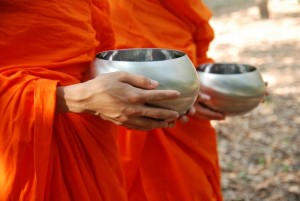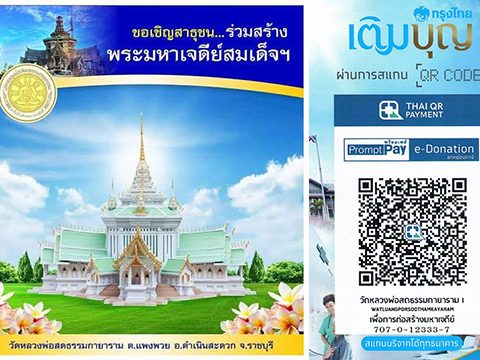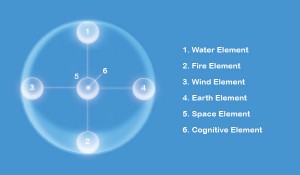
WHAT IS MEDITATION?
Meditation is to train the mind to become peaceful and to stop still in meditation, this is also called Samadhi in Pali. There are four mind components, vision, memory, thought and cognition. When these four stop still at the same point during meditation, it is called concentration of mind. There are two types of meditation, Samatha or Concentration Meditation and Vipassana or Insight Meditation, both of which will be explained later in this section.
WHO CAN MEDITATE?
Meditation is not reserved for Buddhists only. It also helps people from other religions to fully comprehend the depths of their religion.
WHY DO WE MEDITATE?
Meditation has countless benefits for people in all walks of life, especially, the mental benefits. A busy person gets rid of tension and worried person will become calm and find peace. It helps in overcoming fear in the heart and increases an elderly person’s joy of living. There is even strong evidence that it can help alcoholics and drug addicts in overcoming their dangerous habits. It will increase one’s ability to learn and memorize and, moreover, make one a happy person both awake and asleep, not frightened of danger or even of death.
WHAT ARE THE BENEFITS OF MEDITATION?
Meditation is very useful in daily life, even for those who don’t meditate formally. There are five concrete benefits. First, meditation maintains and improves mental health, developing inner peace and tranquility which foster serenity, contentment and happiness. Second, it engenders cool, calm composure, fostering self-possessed, rational behavior, unbiased judgment, and smooth, unruffled social interaction. Third, meditation focuses thought, dispelling confusion and leading to more perceptive analysis and deeper insight. Fourth, it maintains and improves physical health, providing rest and relaxation, averting sickness, and developing strength and vigor. Finally, the fifth and ultimate benefit of meditation is cleansing out the Five Hindrances, which constrict our mental processes, in order to purify the mind to higher levels of consciousness. The Five Hindrances are: drowsiness or laziness, doubt or uncertainty, ill will or enmity, distraction or restlessness, and sensual desire or enchantment.
IS MEDITATING DOING GOOD?
Meditation is the way to train and purify one’s mind. This is very meritorious. Why? When the mind wanders outside, it will contact and attach to worldly objects you like, or feel aversion towards the objects you dislike. That will cause passion to arise in the form of craving, greed, ill will, or delusion. When you meditate and bring your mind inside, even for a second, it is very meritorious because the mind stops unattached to any worldly object. Thus, your mind will become purer and purer. Try to do it everyday, whenever you feel free in any position and at any place.
REVEREND, WHEN YOU SEE THE SPHERE, ISN’T IT SUPPOSED TO BE ROUND? I SEE SOMETHING WHICH LOOKS OBLONG.
Yes, it may be so, but do not be bothered at all. If you stop still at the center (a very transparent spot), you see Dhamma. The Dhamma Sphere enlarges from that spot and becomes a sphere anyway.
WHAT IS THE PROPER TIME TO MEDITATE DURING THE DAY?
It all depends. Some people say in the morning at 3:00, 4:00, or 5:00 am, and some say 9:00 or 10:00 am. Afternoon is not very good. It becomes good again around 7:00, 8:00, 9:00 or 10:00 pm. So, find the best time for yourself.
HOW LONG SHOULD A MEDITATION SESSION BE? HOW MANY MINUTES?
It is recommended about thirty minutes for beginners. After you get used to it, it can be more and more until about an hour. If one is very good, two hours doesn’t matter. Some people change their position by walking and meditating at the same time, it is also called walking meditation. This is another way for meditation and it is very helpful too, especially forest monks who want to be relaxed from sitting and meditating all day.
CAN WE MEDITATE BEFORE GOING TO SLEEP?
Yes, but, it depends upon one’s physical fitness and environment. If you feel exhausted or tired, take a rest. Afterwards, when you can find the proper conditions such as a quiet place, good weather and free time, meditation can be very helpful at any time. It depends upon how you feel. The best way is to try to do as much as you can without forcing it too much. Don’t be too eager. Sometimes you might sit under a tree in good weather for only a couple of minutes and you can see the sphere [mentally see a light object]. Some people can see it while walking along, not sitting formally. When your merit becomes full, you can see it. When your mind becomes tranquil, peaceful and still, you can also see it right away because the mind becomes perfectly concentrated.
CAN WE SAY THAT A LONGER TIME, SAY A MONTH, WOULD INCREASE THE SUCCESS RATE TO 50%?
No, I cannot say that. It may be 40% or even less, because usually fifteen days is the maximum for a person to continue exerting his or her whole effort. Longer than that and the meditator might become bored. You need a rest.
WHY DID LORD BUDDHA TEACH 40 MEDITATION SUBJECTS?
Lord Buddha taught forty meditation subjects or concentration devices for tranquilizing the mind (Buddhaghosa, The Path of Purification or Visuddhimagga). Those Forty Meditation Subjects are:
- 1. Ten Kasina [Kasina means a Meditation Object]
- 2. Ten meditations on corpses (Asubha)
- 3. Six Recollections (Anussati)
- 4. Mindfulness of Death (Maranassati)
- 5. Mindfulness of Body or Contemplation on the 32 Impure Parts of the Body (Kayagatasati)
- 6. Mindfulness of Breathing (Anapanasati)
- 7. Recollection of Nirvana or Contemplation on the Virtue of Nirvana (Anussati)
- 8. Four Divine Abidings or Sublime States of Mind (Brahmavihara)
- 9. Four Arupa Jhanas or the Absorptions of the Formelss Spheres
- 10. Perception of the Loathsomeness of Food (Aharepatikulasanna)
- 11. Analysis of the Four Elements (Catudhatu-vavatthana)
A pactitioner can select any one or combination of these forty meditation subjects, according to his or her own character. For example, Kasina concentration is very suitable for those with sensual desire, restlessness of mind, or inclination toward anger, hatred or ill will. For those whose habits are intellectual thought, devotion or delusion, mindfulness of breathing (Anapanasati) and recollection of Buddha’s virtues (Buddhunussati) are most suitable.
WHAT IS VIPASSANA OR INSIGHT MEDITATION?
Insight or Vipassana Meditation is the technique for developing Right Wisdom. This derives from contemplation of the Four Foundations of Mindfulness (Satipatthana), the physical body, feelings, mind, and Dhamma (phenomena). It includes Right Wisdom with regard to the Five Hindrances, the Five Aggregates, the Four Noble Truths, and the twelve links in the Chain of Dependent Origination. (Paticca-samuppada).
WHAT ARE THE THREE TRAININGS?
The Three Trainings are (1) Training in Morality or Sila, (2) Training in Mentality or Samatha or Concentration Meditation, and (3) Training in Wisdom. They can be summarized into the following table:
| The Noble Eightfold Path | The Three Trainings |
| 1. Right View or Right Understanding (Samma-ditthi), 2. Right Thought (Samma-sankappa), | Training in Wisdom or Pañña, |
| 3. Right Speech (Samma-vaca), 4. Right Action (Samma-kammanta), 5. Right Livelihood (Samma-ajiva), | Training in Morality or Sila, |
| 6. Right Effort (Samma-viriya), 7. Right Mindfulness (Samma-sati) and 8. Right Concentration (Samma-samadhi) | Training in Mentality or Samadhi |
Training in Mentality is developing Samatha Meditation and Training in Wisdom is developing Vipassana Meditation.
WHAT ARE THE FOUR FOUNDATIONS OF MINDFULNESS?
Foundations of Mindfulness, also called Satipatthana in Pali, consist of:
1. Mindfulness of Bodies-In-Bodies
2. Mindfulness of Feelings-In-Feelings
3. Mindfulness of Minds-In-Minds
4. Mindfulness of Dhammas-In-Dhammas
These four are both Samatha and Vipassa Meditations.












 ไลน์ "@wlps" เพื่อรับข่าวสารจากทางวัด
ไลน์ "@wlps" เพื่อรับข่าวสารจากทางวัด
